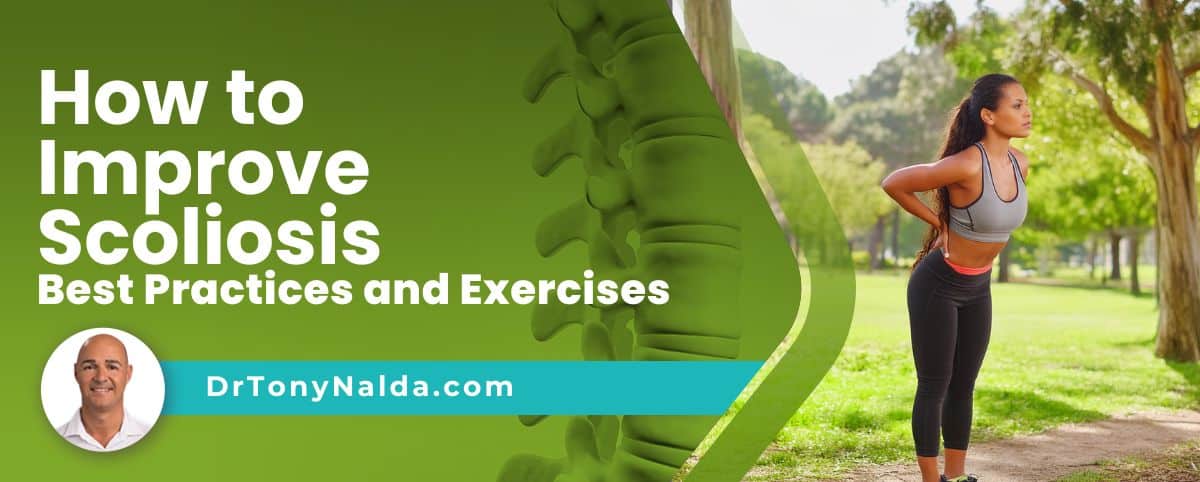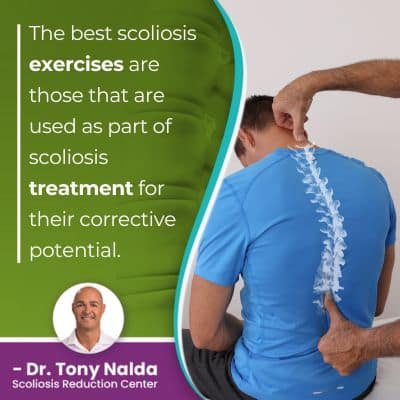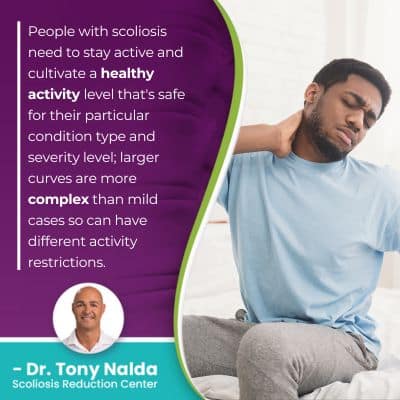How to Improve Scoliosis: Best Practices and Exercises

Scoliosis is a progressive condition, but it can be highly treatable, particularly with early detection and intervention. Knowing the early signs of the condition is important because it can lead to early detection and treatment. The earlier treatment is started, the better.
The best way to improve scoliosis is to treat it proactively; this means addressing its underlying structural nature and using physical therapy and exercises to strengthen the spine and its surrounding muscles, and to keep the spine flexible and responsive to treatment.
As a progressive condition, scoliosis is virtually guaranteed to get worse over time, so let's talk about how best to minimize the condition's effects.
Table of Contents
Being Diagnosed with Scoliosis
Being diagnosed with scoliosis means an unnatural sideways bending and twisting spinal curvature has developed, and this disrupts the biomechanics of the entire spine.
The spine's natural and healthy curves make it stronger, more flexible, and better able to distribute and absorb mechanical stress during movement, so a loss of a healthy curve can affect any of those areas.
Being diagnosed with scoliosis means treatment is needed to improve scoliosis and prevent it from getting worse.
As scoliosis progresses, the spine gets increasingly rigid, making it less responsive to treatment and making patients less capable of performing therapeutic exercises for scoliosis treatment.
As scoliosis gets worse, it's becoming more severe, and the patient's Cobb angle measurement is increasing.
A patient's Cobb angle is a key piece of information that treatment plans are shaped around and what condition severity is based on.
During X-ray, what's happening in and around the spine is visible, and a scoliosis X-ray involves a number of comprehensive measurements to understand the amount of tilt and rotation there is in the spine.
Cobb angle is determined by drawing lines from the tops and bottoms of the curve's most-tilted vertebrae, and the resulting angle is expressed in degrees:
- Cobb angle of between 10 and 25 degrees: mild scoliosis
- Cobb angle of between 25 and 40 degrees: moderate scoliosis
- Cobb angle of 40+ degrees: severe scoliosis
- Cobb angle of 80+ degrees: very severe scoliosis
Here at the Scoliosis Reduction Center, treatment comes in phases that have the goal of improving the spine's mobility, healthy curves, and stability.
The Best Scoliosis Exercises
 The best scoliosis exercises are those that are used as part of scoliosis treatment for their corrective potential.
The best scoliosis exercises are those that are used as part of scoliosis treatment for their corrective potential.
There are two main scoliosis treatment approaches, surgical and nonsurgical, and while a traditional surgical response does little to prevent progression, nonsurgical conservative treatment uses the power of exercise to increase the spine's flexibility, impact curves, and strengthen the spine's surrounding muscles so they can optimally support and stabilize the spine.
So the best scoliosis exercises are those that are integrated into a proactive conservative treatment plan with the goal of preventing progression, increasing condition effects, and the need for invasive surgical treatment in the future.
Here at the Center, exercise is an important facet of treatment, so let's explore the different phases of a conservative treatment approach, and keep in mind, as no two cases of scoliosis are the same, treatment plans are fully customized.
Mobility Phase of Treatment
The mobility phase of treatment is the first, and once conditions are fully classified based on patient age, condition type, severity, and curvature location, a comprehensive assessment is performed on the spine's level of flexibility.
Scoliosis progression causes the spine to become increasingly rigid, making it less responsive to treatment, and making it difficult for some patients to perform key therapeutic exercises as part of treatment.
Once it's determined where any areas of restricted movement and/or hypermobility located within the spine, the mobility phase uses the Center's state-of-the-art equipment for mobility therapy, and mobility exercises are a key part of this facet of treatment.
Equipment like the wobble chair, cervical traction, vibrating traction, and the scoliosis traction chair can help to extend the spine, taking pressure off nerves and pulling the spine out of its unnatural curve.
Exercises designed by a scoliosis physical therapist can also help increase the spine's level of flexibility, facilitate postural awareness, and increase spinal support by strengthening the spine's surrounding muscles.
Schroth exercises and SEAS (Scientific Exercise Approach to Scoliosis) are treatment approaches that are exercise-based and focus on breathing, postural awareness, and core muscles being targeted and strengthened.
The Adjustments Phase of Treatment
The adjustments phase of treatment springboards off the initial mobility phase as it involves condition-specific chiropractic treatment, and if the spine is too rigid, it won't be responsive to chiropractic care that has the potential to impact the condition's underlying structural nature.
Scoliosis is a structural condition, meaning it involves a structural abnormality within the spine itself, so treatment has to primarily address the condition's structural nature, and this is worked towards through a curvature reduction.
Reducing the size of the scoliotic curve means restoring as much of the spine's healthy curves as possible, and this I worked towards through a series of chiropractic techniques and targeted adjustments that have the goal of realigning the spine.
If the most-tilted vertebrae are adjusted so their position is impacted and the spine is more aligned, its biomechanics are improved, condition effects are minimized, and the next phase of treatment is about holding those results and the curvature reduction.
The treatment here at the Center is intensive, and that doesn't mean painful or invasive; it means it's delivered in short high-intensity doses.
Particularly when it comes to treating childhood scoliosis, as progression is triggered by growth, the intensive approach is beneficial as treatment has to focus on holding results despite the constant trigger of growth and development.
The Stability Phase of Treatment
 As a progressive condition, scoliosis treatment isn't about curing scoliosis; it's about how best to manage an ongoing condition for the best quality of life.
As a progressive condition, scoliosis treatment isn't about curing scoliosis; it's about how best to manage an ongoing condition for the best quality of life.
Conservative treatment is a noninvasive and natural form of treatment that preserves as much of the spine's natural strength and function as possible, and certain exercises can help not only as a scoliosis-friendly lifestyle, but also as part of holding treatment results.
Patients entering into the stability phase of treatment have had their spine's mobility assessed and addressed, adjusted for a curvature reduction, and are now ready to apply another series of exercises to further heal and stabilize the spine for long-term sustainable results.
Again, each treatment plan is as unique as the patient themselves, and common exercise-types applied include active and reactive, isometric, self-corrective, and specific body molding; these exercises can increase core muscles strength so the spine is optimally supported and stabilized, improve posture, and maintain spinal mobility.
Performing custom-prescribed scoliosis exercises with proper technique can lead to stronger stomach muscles, a spine that's more flexible, good posture, improvements in bone health, reducing pain, and preventing curve progression.
People with scoliosis need to stay active and cultivate a healthy activity level that's safe for their particular condition type and severity level; larger curves are more complex than mild cases so can have different activity restrictions.
Pelvic tilts and hip extensor exercises can help keep the lower back strong and flexible, and postural awareness helps during all exercises and activities: keeping the head straight while walking and/or running, feet shoulder width apart during strengthening exercises, knowing when to take deep breaths, and keeping feet flat on the floor.
Conclusion
When it comes to a progressive spinal condition like scoliosis, each patient will have their own experience of life with the condition, but common effects can include postural changes such as uneven shoulders and hips, a rib cage arch, and for adults, it's pain.
Bone maturity is an important factor in scoliosis because the condition doesn't become compressive until skeletal maturity has been reached, and that's when compression of the spine and its surrounding muscles causes back pain and pain that radiates into the extremities due to nerve compression.
Scoliosis exercises can also help with pain management by keeping the spine as flexible as possible and its surrounding muscles as balanced and strong as possible so less pressure is on the spine.
If scoliosis is causing pain, a personal trainer can help guide patients on how best to minimize back and muscle pain, but no exercise, or exercise regime, should be introduced without it first being cleared by the patient's scoliosis treatment provider.
While exercise has a place in scoliosis treatment, there are also certain activities and exercises that are deemed unsafe for people with scoliosis, and these include those that overuse one side of the body, place the spine in unnatural positions, or introduce repeated stress/tension from impact.
As a 3-dimensional condition, a scoliosis curve needs to be impacted on multiple levels, which is why an integrative approach combining multiple facets and phases of treatment can be so effective; in addition, treatment disciplines can be adjusted and apportioned accordingly based on how the spine is responding to growth and/or treatment.
Keeping the spine in a neutral position is important as this means limiting adverse spinal tension, and scoliosis exercises, when combined with other facets of treatment with corrective potential can help realign and strengthen the spine and its surrounding muscles.
Dr. Tony Nalda
DOCTOR OF CHIROPRACTIC
After receiving an undergraduate degree in psychology and his Doctorate of Chiropractic from Life University, Dr. Nalda settled in Celebration, Florida and proceeded to build one of Central Florida’s most successful chiropractic clinics.
His experience with patients suffering from scoliosis, and the confusion and frustration they faced, led him to seek a specialty in scoliosis care. In 2006 he completed his Intensive Care Certification from CLEAR Institute, a leading scoliosis educational and certification center.
About Dr. Tony Nalda
 Ready to explore scoliosis treatment? Contact Us Now
Ready to explore scoliosis treatment? Contact Us Now





